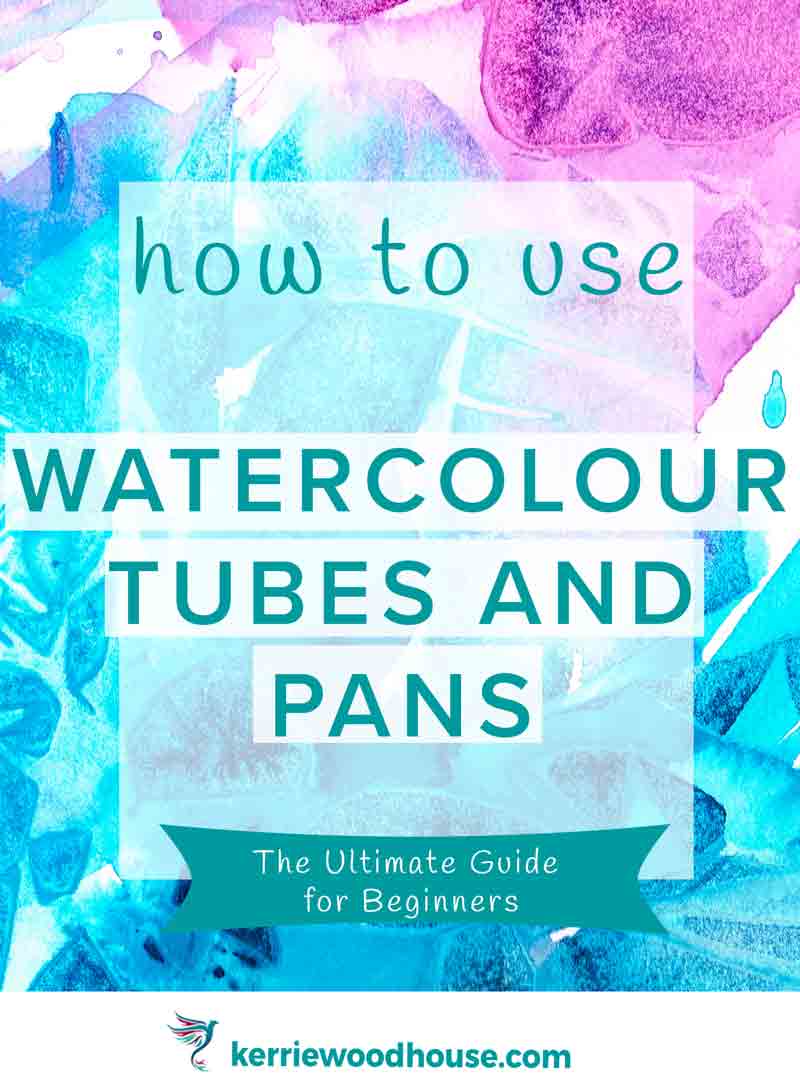I bet you’ve heard that you can’t fix watercolor mistakes. That’s just not true - in fact I want to show you how I fix an entire bad watercolor painting. I’ll even show you my bad painting (yes - there’s a video of my bad painting at the end of this article 😉)
I’ll also cover all the steps I took to fix my watercolour painting so that you will know what to do when this happens to you. Because, and it's only fair to warn you, bad paintings are an inevitable part of the process.
But first… we do need to get a few things straight.
A word like ‘mistake’ should be used with caution when it comes to watercolor. Given the wilful unpredictability of watercolor paint, outcomes are always uncertain. So is there really much that we can actually describe as a watercolor mistake?
Let’s call them surprises, rather than mistakes and hopefully we will even get to stretch to Happy Little Accident.
I also want to say that I bristle a little at the term bad painting, because good and bad is entirely subjective. The only person you really need to please is you.
But if you do end up with a watercolor mistake (ahem… watercolor surprise) or indeed an entire ‘bad’ painting here are a few watercolor techniques you can try to fix the problem.
How to Fix a Mistake in Watercolour
Remove a Watercolor Mistaken by Blotting Immediately
If you have just made a watercolor mark that you wish you hadn't you can take immediate action and blot it with a kitchen towel. If the paint is still wet you may be able to remove all or at least most of the paint. I find a good quality absorbent kitchen towel can work wonders when pressed onto the wet watercolour mistake. (My preferred brand is Viva if you were wondering.)
Use the Lifting Out Technique to Fix a Watercolor Mistake
The lifting out technique in watercolor is a similar approach to the blotting. Sometimes a brush is a better choice than the paper towel if you feel you need a bit more control. Use a dry brush (I like to call this a thirsty brush to press into the wet paint you want to remove and lift it out. Since the brush is made to hold paint and water it should suck up the damp paint quite well. However results will vary depending on
How damp the paint is
Whether or not you have a staining colour
The quality of your watercolour paper (Bockingford or Arches works well)
You can go back a second time with this technique. First use a clean, damp brush to apply a little clean water to the area you want to remove. (Incidentally, you can even try this approach on an area of dry paint.) The water and brush should activate the paint again which leaves you able to blot it out with a kitchen towel, or a sponge, or a dry brush. You can even try a cotton bud if you have one on hand.
By the way, if you want to know more about watercolour supplies, I have a whole class on that. It’s free, and you can sign up here.
The Beginner’s Guide to Watercolour Supplies
Cover a Watercolour Mistake
Hopefully you can remove a watercolor mistake entirely using the above methods which is ideal if you weren't planning to paint over this area.
There will be times when you either want, or have to paint over the area with the mistake. Even If you are planning to paint over your little mistake it is best to try and remove the mark you don’t like first.
It is quite likely that you will be able to hide the mistake entirely by painting over it. Watercolour paint is mostly transparent so you will see some of what is underneath. Even if you have a pale shadow of the old mark it might still be alright. Painting over a pale mark with a darker colour will often cover up the initial mark just fine.
Be careful to let the dampness dry completely in the area where you used your lifting technique, unless soft edges are what you are looking for. Effectively you will be painting wet into wet if the corrected ‘mistake’ is not yet dry before you attempt Operation Cover Up.
Ok, so now you have some techniques to use for the case of a mistake or two in your watercolour painting. But what about an entire painting that you don’t like?
This happened to me very recently. (And I have no doubt it will happen again).
How I Fix a Bad Watercolor Painting
Before I show you my bad painting and how I went about fixing it we should discuss what usually makes us feel like a painting isn’t working.
4 Painting Problems and How to Fix Them
Clearly I can’t give you an exhaustive list of causes here but I can identify a few of the most likely possibilities.
Composition - you basically don’t like the arrangement of the main elements in the painting. This is potentially hardest to fix but you may be able to add something to improve the layout and balance eg an extra flower to balance the floral arrangement, or a tree thoughtfully added to the landscape
Value - a ‘meh’ painting is usually a painting with insufficient value contrast. See if you can strengthen the darks and/or lighten the highlights. (This article gives you a useful exercise for building your value muscles.)
Lack of unity - too many colours. Sometimes we can go a little wild with the rainbow and use too many colours. A limited colour palette creates a nice harmony to a painting. (See how I approached that in the video below)
Dull or boring colours - watercolours dry paler than they appear when you are painting so you might have to intensify the colour with another layer (glazing technique). If you want to give the painting a little pop you can consider adding a little of a complementary colour - more on that here)
In the painting I am about to show you I think my problems were the second and third from this list. A little ‘meh’ with not enough contrast for my liking and a few too many colours - even for a colourful sunset like this one.
Summary of My Process to Fix this Painting
I boldly sprayed the entire painting with water to reactivate the paint. Instead of blotting, which may not have worked because there was just too much pigment on the page, I tipped the painting and let the activated paint run off. I used the kitchen towel to soak up these rivers of paint because if you leave them you will likely have backruns and cauliflowers at the edges of your painting.
I repeated this process till I had a pale version of my original painting and had almost entirely removed the dark marks I had most recently painted in the bottom of the composition.
Once that was completely dry I painted in the important aspects I felt were missing. Those were the lovely scalloping shoreline that was an important part of the composition and the dark values both in the bottom of the painting as well as the top corners. I also added the darks in the horizon line to improve the overall value structure. Having concluded that I had gone a bit wild with colour the first time I made sure to stick to only the limited colours that were already in the original painting.
I have to say it was so much fun.
It's actually quite marvellous to make a bad painting.
No really.
You see, once you have decided you have ‘ruined’ the painting you have nothing to lose. Expectations are eliminated. You can just play. And playing is when you learn the most. The paper has already been used. You may as well keep on experimenting with it.
So my final thought here is, don’t give up on your painting.
There is always something you can do.
Maybe you will fix the bad painting to your satisfaction.
Maybe you won't.
But it sure is fun either way, and you are bound to learn a whole lot more than if you give in to the temptation to just chuck a ‘bad’ painting in the bin.
Are you on your own painting journey?
One of these might be useful…









